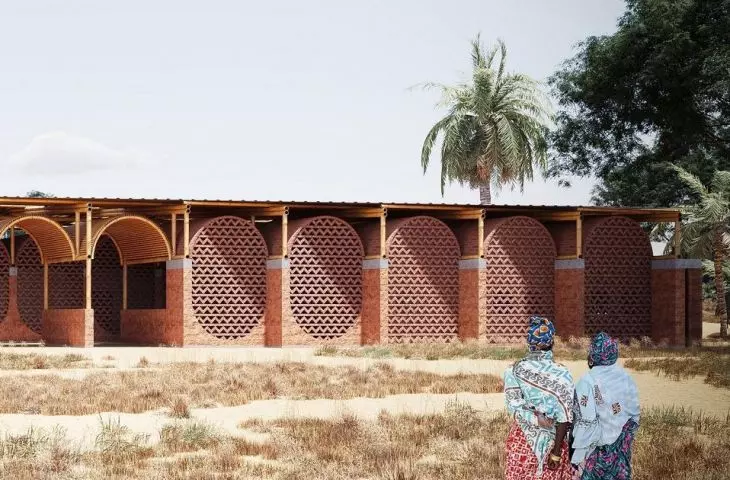Siarhei Karoza, a graduate of the Faculty of Architecture at the Cracow University of Technology, has won a prestigious award, placing in the top 50 in the Kaira Looro 2024 competition. In the competition, which received some 900 entries from 112 countries this year, participants were tasked with designing a Maternity Center in Senegal .
axonometry
© Siarhei Karoza
Kaira Looro Architecture Competition 2024
This year's competition challenge was to design a Maternity Center in Senegal. The one-story building was to be buildable together with the local community. The task was to create a space friendly to patients and their relatives, including a reception area, waiting room, areas for medical staff, examination and consultation rooms, maternity wards, delivery rooms, a sterile operating room and a newborn observation area. We published the results of the competition on our portal.
diagram
© Siarhei Karoza
Siarhei Karoza's concept
The Architecture graduate's project involves the creation of an oasis of support, care and healing for mothers-to-be and their newborns. The project aims to address the region's unique social, cultural and climatic challenges, while providing state-of-the-art medical facilities in a welcoming and soothing environment. The architectural approach is based on the principles of sustainability, cultural sensitivity and functionality.
visualization
© Siarhei Karoza
The design draws inspiration from traditional Senegalese architecture, combining modern healthcare needs with local building techniques and materials. The design uses locally sourced clay bricks, rammed earth walls and bamboo to create a harmonious blend of old and new, promoting a sense of familiarity and comfort for the community. The center is organized linearly to facilitate a smooth and logical flow from one area to another, ensuring efficiency and ease of movement for patients, staff and visitors. The entrance courtyard welcomes patients, providing a reassuring first impression. This space leads to the reception and waiting areas, designed to be airy and filled with natural light, reducing anxiety and promoting well-being.
visualization
© Siarhei Karoza
The design maximizes natural ventilation and shading to combat Senegal's hot climate. The windows, strategic orientation of the building and use of courtyards ensure that the building remains cool and comfortable year-round. The integration of green spaces not only improves aesthetics, but also contributes to the overall well-being of patients and staff. This maternity care center is a thoughtful blend of traditional and modern design that aims to provide quality healthcare in a nurturing and culturally appropriate environment. The project aspires to be more than just a medical facility; it strives to be a beacon of hope and support for the entire community.
visualization
© Siarhei Karoza
construction process
The project to create a maternity center begins with laying a foundation of compacted earth and stones, reinforced with concrete to provide a solid base for the structure. Load-bearing walls are then erected using laterite bricks, creating a foundation for further work. The floors are made of poured concrete with broken tiles, using compacted gravel and sand as a base to ensure reliability and durability. To strengthen the structure, load-bearing walls are connected by concrete beams, and cradle vaults are built between them to ensure the stability and reliability of the building. On this foundation, bamboo structures are erected, on which corrugated sheets are laid to form a solid roof. Next, latticed walls of clay bricks and partitions are proceeded with, giving the building an aesthetic appearance and lightness. Finally, doors and windows are assembled from wood and bamboo, adding functionality and style to the center's overall architecture.
visualization
© Siarhei Karoza
materials
For most of the construction in the project, Siarhei Karoza uses local clay bricks. These bricks were chosen for their thermal properties, which help regulate the temperature inside the building by absorbing heat during the day and releasing it at night. In addition, the use of local materials supports the local economy and reduces emissions from transportation. The project also uses rammed earth walls for their environmental benefits and aesthetics. This traditional construction technique uses local soil mixed with a small amount of cement for stabilization. Its natural appearance blends into the landscape, creating a soothing and grounded atmosphere.
visualization
© Siarhei Karoza
Laterite stone, commonly available in the region, is usedfor the supporting walls and provides excellent structural stability. Its natural thermal properties help keep the building cool inside, and its rustic appearance adds to its charm. Bamboo is used for a variety of structural and decorative elements, including the roof structure. It is a fast-growing, renewable raw material that is both strong and flexible.
visualization
© Siarhei Karoza
Thefloors are made of poured concrete, providing a durable and easy-to-maintain surface suitable for high-traffic areas. In addition, decorative tiles made from broken pieces of local ceramics are embedded in the screed, enhancing aesthetics and recycling materials. The roof is made of corrugated sheet metal, which is durable and effectively reflects sunlight, reducing heat load. This type of roof is also excellent for providing natural ventilation, as it can be designed to release hot air and draw in cool air.
detail
© Siarhei Karoza
Thecenter's windows and doors are made of rosewood, chosen for its durability and beautiful aesthetic qualities. Using these materials, Siarhei Karoza's design creates a sustainable, resilient and culturally meaningful health center that meets the specific climatic and social needs of the Senegalese community.
















































